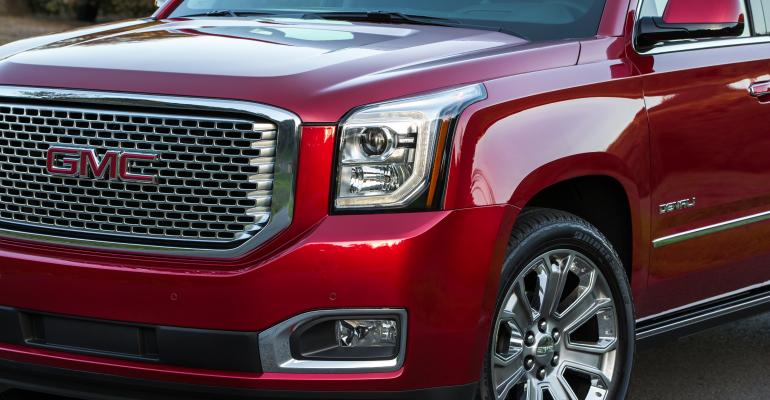They seemed destined for extinction in 2008, devastated by soaring gas prices and a crashing global economy, but big body-on-frame SUVs are mounting a comeback, thanks to a loyal customer base, strong export markets and a flurry of new products.
At least that’s the plan at General Motors, which controls about 75% of the segment and is launching a fusillade of new models that’s starting to hit showrooms now and will continue through spring. GM’s controversial Hummer brand was phased out in 2010, but the automaker still dominates with trucks such as the Chevy Tahoe and Suburban, GMC Yukon and Cadillac Escalade.
GM started 2014 with plenty of momentum. Sales of the current Tahoe, the volume leader, were up 21% in 2013 to 83,502 deliveries, according to WardsAuto data, while others in the segment slid backwards or were stuck in neutral. The only exception was Jaguar Land Rover, which introduced a new Range Rover last year and saw a 56% jump to 12,221 units.
Deliveries tanked through the first two months of 2014 but are expected to get back on track in the spring when the weather improves and the new sheetmetal starts hitting dealer showrooms.
No one is expecting the large/luxury SUV segment to return to its glory days of 2003 and 2004, when gas was $1.50 a gallon and more than a million of the monsters were sold annually in the U.S. But a surprisingly robust number of almost-forgotten nameplates still are in the game and set to compete for the foreseeable future.
 Even though it’s only a third the size it once was, the niche remains big enough to support five automakers and 14 models. Overall sales were up 8.5% to 323,097 in 2013, and profits can be substantial even if volumes are low, thanks to sticker prices that range into the high five figures.
Even though it’s only a third the size it once was, the niche remains big enough to support five automakers and 14 models. Overall sales were up 8.5% to 323,097 in 2013, and profits can be substantial even if volumes are low, thanks to sticker prices that range into the high five figures.
WardsAuto’s forecast does not show any of the current five players bailing out through 2020. Even though the brutes are a drag on corporate average fuel economy, the reasons all these automakers are sticking with this politically incorrect sector are the same: big potential profits and lucrative markets in the Middle East.
Ford is offering refreshed versions of its Expedition and Lincoln Navigator this fall; Nissan renamed the Infiniti QX56 Titan pickup-based SUV the Infiniti QX80 last year and continues to offer its imposing Armada based on the same platform. Meanwhile, Toyota is expected to continue forging ahead with its Tundra-based Sequoia and Lexus LX.
In GM’s case, the target market for its new vehicles is the large pool of loyal fullsize SUV owners: millions of affluent Baby Boomers whose current vehicles are 11 years old and nearing the end of their useful life. Plus, demand remains high in export markets such as Saudi Arabia and Dubai.
As much as 25% of GM’s fullsize SUVs are exported to the Middle East, a spokesman says.
GM insiders freely admit the heyday of the SUV was much like the real estate bubble of the same era: pumped up by subsidized leases, cheap gas and impulsive buyers who did not really need the capabilities of a traditional SUV and were in over their heads financially.
Those buyers since have migrated to smaller car-based cross/utility vehicles or other vehicles. The core buyers that remain really do require the toughness, seating flexibility and towing capacity only a traditional SUV can provide – or they at least can afford the vehicle and the cost of filling the tank.
“Today’s Tahoe and Suburban customers are using their fullsize SUV to meet their lifestyle needs,” says Mark Clawson, Chevrolet Tahoe and Suburban marketing manager. “Tahoe is more of a daily driver, with occasional use of the third-row seat, while Suburban is the vehicle counted on for carrying a larger crew, be it a larger family or for larger cargo.”
Suburban owners are seven times more likely to transport passengers in the third row on a daily basis than Tahoe owners and three times more likely to use their vehicle for transporting kids to school, Clawson says.
Like the vehicles themselves, five major automakers find the large/luxury utility segment impossible to ignore.





